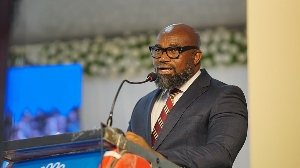- Home - News
- TWI News | TV
- Polls
- Year In Review
- News Archive
- Crime & Punishment
- Politics
- Regional
- Editorial
- Health
- Ghanaians Abroad
- Tabloid
- Africa
- Religion
- Election 2020
- Coronavirus
- News Videos | TV
- Photo Archives
- News Headlines
- Press Release
Opinions of Wednesday, 14 November 2012
Columnist: Sakyi, Kwesi Atta
Could we have Averted the Melcome Monstrosity in Ghana?
By Kwesi Atta Sakyi 11th November 2012
King Hammurabi reigned from 1792 to 1750 B.C. in ancient Babylon of Mesopotamia, some 4000 years ago. He was said to have made the draconian Hammurabi Code, a set of harsh laws to regulate the lives of his subjects in his vast empire, and the laws covered every facet of life in the then world. The numerous laws were based on the principle of tit-for-tat or reciprocity or what is popularity known as ‘an eye for an eye and a tooth for a tooth’.
For example, if a builder constructed a house and it collapsed on the client or any of his relations, then the contractor or builder or project manager should also be put to death. In modern times, it will play out like this. If a teacher teaches a child and he fails an exam, the teacher should forfeit his salary or he should be suspended or experience a sack. If a Black Star player misses a penalty kick, he should be lynched. If a medical doctor performs an operation and the patient dies, the doctor should be put to death as well.
The list goes on ad infinitum. Perhaps, we need such a draconian law in Ghana, especially in the Accra Metropolitan Authority (AMA), and in all the city and town planning outfits across the country, which have notoriously been involved in kickbacks, bribery and corruption, neglect of their duties and oversight. Would that be tantamount to overkill?
I guess we have nation wreckers and saboteurs in our midst who are failing to carry out their bounden duties and they are rather busy lining their pockets with bribes and glossing over their professional duties of overseeing that structures which go up are properly scrutinized and sanctioned before they get a permit or planning permission. According to Margaret Jackson’s article on Ghanaweb ( see article dated 12/11/12), the Ga West Municipal Director who granted the permit, one Carl Henry Clerk, and the owner of the edifice, one Nana Nkansah Ayeboafo are in custody, helping with BNI investigations.
Anyone putting up a structure, be it a shack or an imposing edifice in the precincts of Accra, needs a nod from the city planners before the structure gets off the ground. A building inspector has to be at the site to approve the profile or ground plan. The plan will undergo stringent scrutiny before the final greenlight is given.
I come from a family where my father was a mason or bricklayer, my 85 year old elder brother is a mason and another elderly brother who passed on a decade ago was also a mason, my maternal uncle was a mason foreman of works in Takoradi, currently my nephew is a mason and he was part of the team that constructed my house in Winneba, a lot of my cousins from my father’s side were veritable artisans of the highest order in places like Accra, Tema, Sekondi and Takoradi. These were accomplished carpenters, masons, steel benders and veteran artisans. One of them was the foreman or overseer at the defunct State Construction Corporation (SCC) in Accra. None of these relatives, despite not having formal architectural degrees, would have built a house that would have collapsed. What has become of some of our modern builders in Ghana, some of whom wield HND diplomas and certificates from trade schools?
Perhaps, we need the ancient trade guilds of Europe to regulate the ranks of builders in Ghana. In my teenage years in the 60s, I followed my father mason to work on many building sites, and on one occasion, a hammer fell on my left big toe which caused the nail to eventually come out. I would have become a mason or bricklayer if I had not done well at school. What I am trying to get across here is that, I come from a background of builders and I see no reason why there should be a collapse of a building in Accra of all places, which would cause the needless deaths of dozens of innocent people and cause injury to many others. At the last count, 18 people are reported dead and 78 were pulled out alive with injuries.
The Melcom six storeys building in Achimota could have been constructed under bizarre circumstances, because such an imposing edifice could not have evaded the radar of AMA and gone unnoticed by the city authorities. Who were the architects, and who was the contractor? Who were the consultants? Who approved the plans? What trade grades did the builders have? Is it not time we re-introduced the labour card which we had in those halcyon days, whereby every artisan, whether private or public with say the PWD or SCC, had to undergo trade tests and the grade obtained was written on their labour cards for any would-be employer to inspect? Was the Melcom building project single-sourced or did it follow transparent and competitive tender and bidding procedures before the contract was awarded? Was the building engineer a member of the Engineers Association of Ghana?
Ghana, as a former British Colony, has a fine tradition of builders and this Melcom disaster has tarnished the image of our builders and the fine tradition built over the years. I am sure when the Portuguese landed on our shores in 1472, led by people like Bartholomew Diaz, Pedro d’ Escobar, Diago d’ Azambuja, Fernando Gomez, and later they started building their castles at Elmina, they would have employed some of our people as slaves. Our building skills could have developed from there. If not, the skills could have been antedated by those of our forebears who brought such skills with them from ancient Ghana or Timbucktoo, nay before that, from ancient Egypt and Iran. I am told on good authority that some Ghanaians originally came from Nubia and Lower Egypt, hence our prowess in local crafts such as Kente weaving, goldsmithing, pottery making, and blacksmithing, among others.
In 1965, during the construction of Job 600 in preparation for the impending OAU Conference in Accra, some workers died from some building accident at the site, as the project was being rushed to meet a deadline. My elder brother, who is luckily alive today at 85 years, was part of the SCC workers on the project. Even as illiterate as some of our builders are, they are well versed in the nitty-gritty of building and they do consult widely among themselves for best practice. However, during their time in the past, our builders were not used to the construction of high rise buildings. Melcom building would not have collapsed if the builders had followed the principles and procedures of project management.
It has come to light that Melcom is a retail chain in Ghana and its owner is one Khubchandani. This family has been in the retail business for many many years, even during the first republic. The matter is currently being investigated by the state security wings and the government of President John Mahama has vowed to set the records straight by getting to the bottom of the matter. Since the matter is sub judice, it is premature to speculate its outcome. However, suffice to say that something snooky, spooky, sleazy and fishy could have taken place before the construction of the Melcom outfit, which has eventually culminated in its falling like a pack of cards or like the Twin Towers of New York which fell on 11th of September 2001 due to terrorist attacks, using aeroplanes to crash into them. Already, tongues are wagging and waxing that the owner of the Melcom building is a top rank financier of the NPP. (see Margaret Jackson’s article of 12/11/12 on Ghanaweb). How the ugly face of politics manages to pop up in every event in Ghana is hard to decipher. Is our politics descending into an abysmal abyss?
We must commend NADMO (National Disaster Management Organisation) for the speedy response to the emergency. Of course, they do not possess the expertise or technology of say the New York Fire Departments (NYFD) or that of the Royal Engineer Corps in Britain, yet NADMO did their best by coordinating the rescue effort and bringing in 9 Israeli experts who came in with sniffing dogs. We must doff off our hearts to NADMO and the Israelis for the wonderful job in saving lives, as the gesture will not go unnoticed.
However, it became glaring that NADMO needs to be equipped with advanced equipment and expertise to deal with disaster of that magnitude. It was especially very tricky to get into the rubble and pull out victims, some of whom were still alive. When I saw the pictures on the internet, I was flabbergasted and beside myself with shock and horror. I heard the news first break on BBC radio. May the souls of the 18 or so dead repose in perfect peace! This disaster reminded me of the Fukushima Nuclear Disaster in Japan, Accra Stadium Disaster, truck accident in Senya Beraku, the BP Gulf Oil disaster in 2009, among others.
The Melcom disaster is a wake up call to our engineers, architects, builders, city and town planners and all stakeholders for them to tighten the screws by conducting due diligence before any structure takes to the skies like an aeroplane. Accra being an earthquake prone area, as well as a coastal location, runs the risk of earth tremors and tsunamis. This being the case, there is need to carry out extensive soil tests before any mighty structure is put up. The architectural designs ought to be stringently verified before approval.
Let us hope this shameful and tragic disaster will not recur. We hope the bribery and corruption which might have led to this unmitigated disaster will be nipped in the bud through huge reforms. Dr Okoh Vanderpuije and his team must be on their guard and be the vanguard of reforms. I recommend that AMA should set up a task force to go round the city of Accra to demolish illegal structures.
Landlords of huge buildings in Accra should be made to have risk mitigation and preventative maintenance measures such as carrying our periodic inspections of their properties, having stand-by standard procedures for evacuation in emergencies such as fire outbreak bomb scares, terrorist attack, among others. As Accra is expanding very fast, we must also be risk conscious to prevent risks from manifesting as hazards.
We must be vigilant and proactive in detecting potential risks and reporting them to the relevant authorities. All businesses housed in huge buildings must maintain a risk register to record potential risks and periodically update their risk factors into high, medium and low risks. Risk management, risk reduction, risk transfer, risk avoidance and risk sharing should be part of their strategies. This disaster also raises the profile of the insurance industry and the need to insure our properties against unforeseen contingencies. It is fitting and proper that the state has compensated the affected families.










